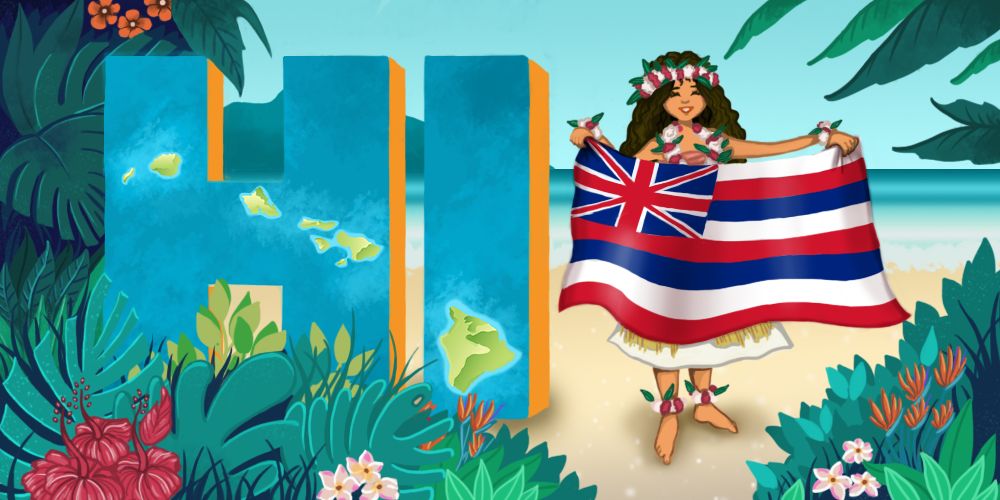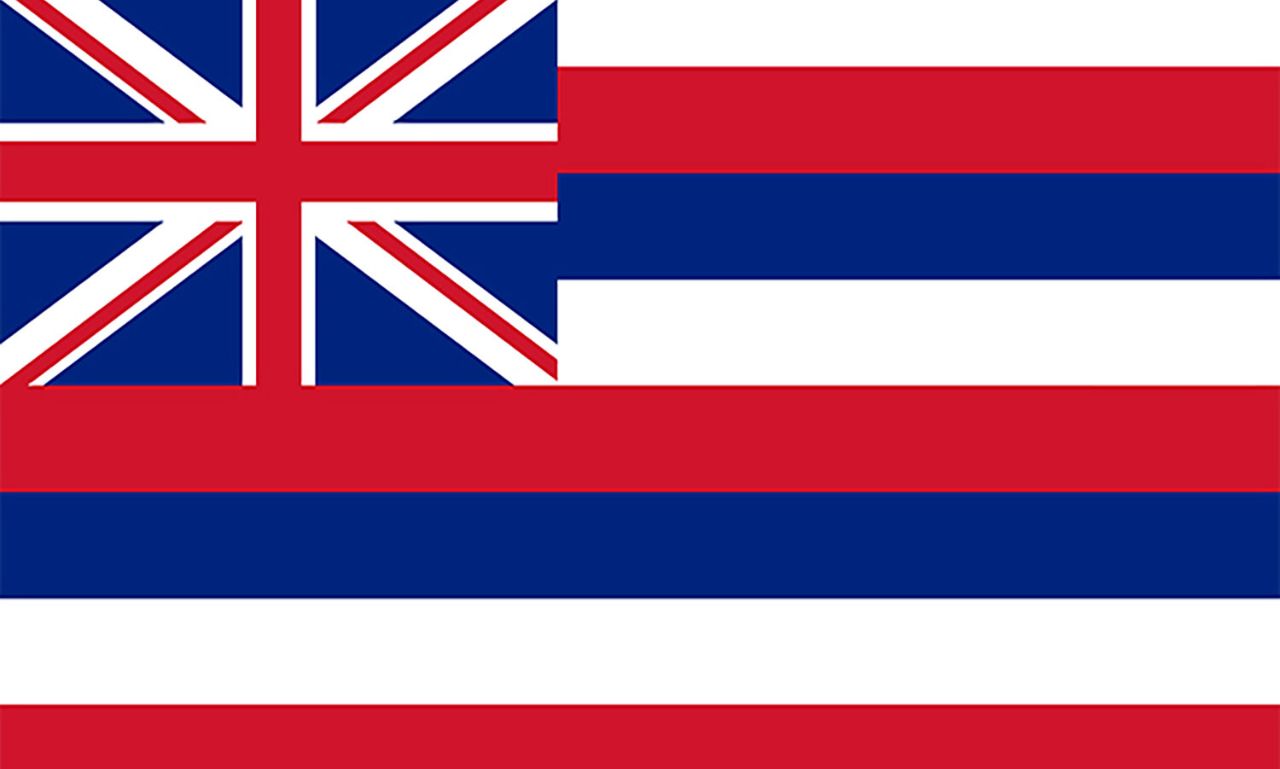The Hawaiian flag, known as Ka Hae Hawaiʻi, is a picture affluent ever, meaning, and social significance. Its special plan mirrors the mind boggling history of Hawaii, where different impacts from around the globe meet. This article dives into the set of experiences, imagery, and contemporary meaning of the Hawaiian flag, investigating its excursion from the mid nineteenth 100 years to the current day.
Authentic Foundation
The starting points of the Hawaiian flag date back to the mid-1800s, during the rule of Lord Kamehameha I, the organizer and first leader of the Realm of Hawaii. Kamehameha looked to lay out Hawaii as a sovereign country in the midst of expanding unfamiliar presence, especially from England and the US.
As indicated by authentic records, the main Hawaiian flag was made around 1816. Its plan was impacted by both English and American flags, mirroring the international scene of the time. Rumors have spread far and wide suggesting that the plan came to fruition as a split the difference between the two powers. Kamehameha’s coalition with English maritime skipper George Vancouver and the developing American impact in the Pacific assumed urgent parts in molding the flag’s plan.
Plan and Imagery
The Hawaiian flag’s plan is a striking combination of English and American components, epitomizing the island’s multicultural legacy and political history. The flag comprises of eight flat stripes of white, red, and blue, addressing the eight primary islands of Hawaii: Hawaiʻi, Maui, Oʻahu, Kauaʻi, Molokaʻi, Lānaʻi, Niʻihau, and Kahoʻolawe. At the upper left corner, it includes an Association Jack, representing Hawaii’s verifiable relationship with England.
- Association Jack: The presence of the Association Jack in the Hawaiian flag’s canton is a demonstration of the verifiable ties among Hawaii and England. During the late eighteenth and mid nineteenth hundreds of years, English pilgrims and brokers were among the main Westerners to connect with the Hawaiian Islands. Commander James Cook’s appearance in 1778 denoted the start of critical collaborations between the Hawaiian realm and the English Domain.
The Association Jack additionally represents Hawaii’s acknowledgment and regard for English maritime power and its job in Hawaii’s initial turn of events. In any case, it is fundamental to comprehend that the flag doesn’t suggest English domain over Hawaii yet rather a verifiable affirmation of common regard and strategy.
- Stripes: The eight level stripes of the Hawaiian flag hold significant importance. Each stripe addresses one of the really Hawaiian Islands, representing solidarity and the aggregate character of the Hawaiian archipelago. The rotating shades of white, red, and blue mirror the normal magnificence of the islands and the soul of Salud that saturates Hawaiian culture.
- White: white connotes virtue and harmony, esteems well established in Hawaiian customs and otherworldliness.
- Red: Red addresses the strength and mental fortitude of the Hawaiian public, their versatility even with difficulties, and their assurance to safeguard their social legacy.
- Blue: Blue represents the huge sea that encompasses the islands, implying the interconnectedness of the Hawaiian nation with the ocean and the more extensive world.

Advancement of the Flag
Throughout the long term, the Hawaiian flag has gone through a few changes, each reflecting various periods of Hawaiian history. At first, the flag included nine flat stripes, yet it was subsequently altered to eight stripes to precisely address the eight fundamental islands.
During the reign of Lord Kalākaua in the late nineteenth 100 years, the Hawaiian flag turned into an image of obstruction against unfamiliar mastery. Ruler Kalākaua, otherwise called the “Merrie Ruler,” looked to resuscitate Hawaiian culture and customs notwithstanding expanding Western impact. The flag, with its particular plan, turned into a strong seal of Hawaiian personality and power.
- The Defeat of the Hawaiian Government: Perhaps of the main occasion in Hawaiian history happened in 1893, when Sovereign Liliʻuokalani, the last dominant ruler of Hawaii, was toppled by a gathering of American financial specialists fully supported by the U.S. government. The defeat denoted the finish of the Hawaiian Realm and the start of Hawaii’s extension by the US.
During this turbulent period, the Hawaiian flag took on new layers of importance. For the majority Local Hawaiians, the flag turned into an image of obstruction and dissent against the deficiency of their sway. It addressed the persevering through soul of the Hawaiian public and their assurance to recover their social and political character.
- Statehood and Contemporary Importance: Hawaii was formally added by the US in 1898 and turned into the 50th state in 1959. Regardless of the political changes, the Hawaiian flag kept on holding profound social and authentic importance. Today, it is flown close by the American flag at government structures, schools, and homes across the state.
The flag’s contemporary importance goes past its verifiable roots. It fills in as a strong sign of Hawaii’s novel legacy and the continuous endeavors to safeguard and advance Hawaiian culture. The flag is an image of pride for Local Hawaiians and a portrayal of the different and comprehensive soul that describes current Hawaii.
The Flag as a Social Token
The Hawaiian flag is something beyond an image of statehood; a social seal typifies the embodiment of Hawaiian personality. It is unmistakably highlighted in different far-reaching developments, celebrations, and services, mirroring the profound association between the Hawaiian public and their property.
- Merrie Ruler Celebration: Quite possibly of the main far-reaching development in Hawaii is the Merrie Ruler Celebration, held every year in Hilo on the Large Island of Hawaii. The celebration celebrates hula, the conventional Hawaiian dance, and praises Ruler Kalākaua’s inheritance. The Hawaiian flag is conspicuously shown during the celebration, representing the festival of Hawaiian culture and the protection of its customs.
- Hoʻolauleʻa and Salaam Celebrations: The Hawaiian flag likewise assumes a focal part in other social festivals like Hoʻolauleʻa and Salaam Celebrations. These occasions feature Hawaiian music, dance, expressions, and specialties, advancing a more profound comprehension and enthusiasm for Hawaiian culture. The flag, with its dynamic tones and verifiable importance, fills in as a bringing together image during these merriments.
The Hawaiian Sway Development
The Hawaiian flag remaining parts a powerful image in the continuous Hawaiian sway development. Numerous Local Hawaiians keep on supporting for the acknowledgment of their authentic and political freedoms, looking for more prominent independence and self-assurance.
- Image of Obstruction: For allies of the sway development, the Hawaiian flag addresses an image of opposition against imperialism and the battle for equity. It typifies the goals of the Hawaiian nation to recover their social legacy, land, and self-administration. The flag is frequently seen at fights, rallies, and far-reaching developments, filling in as a strong visual portrayal of the development’s objectives.
- Instructive Drives: The Hawaiian flag likewise assumes a part in instructive drives pointed toward bringing issues to light about Hawaiian history and culture. Schools and local area associations utilize the flag as a helping instrument to instruct youthful Hawaiians about their legacy and the significance of protecting their social personality.
Conclusion:
The Hawaiian flag, with its rich history and significant imagery, remains as a demonstration of the versatility and getting through soul of the Hawaiian public. From its beginnings during the rule of Lord Kamehameha I to its contemporary importance in the Hawaiian sway development, the flag has developed into a strong seal of Hawaiian character and pride.
As Hawaii keeps on exploring its mind boggling history and social scene, the Hawaiian flag fills in as a sign of the significance of saving and praising the one of a kind legacy of the islands. Whether showed at social celebrations, instructive drives, or political conventions, the flag remaining parts an image of solidarity, strength, and the persevering through Salaam soul that characterizes Hawaii.
FAQ’s:
- What does the Hawaiian flag represent?
The Hawaiian flag represents the rich history, social legacy, and solidarity of the Hawaiian Islands. It highlights eight stripes addressing the eight primary islands and an Association Jack, recognizing verifiable binds with England.
- When was the Hawaiian flag created?
The flag was made around 1816 during the rule of Lord Kamehameha I. Its plan was impacted by both English and American components.
- Why does the Hawaiian flag have the Association Jack?
The Association Jack in the Hawaiian flag mirrors Hawaii’s authentic connection with England and recognizes early English impact and strategy during the realm’s early stages.
- What number of stripes are on the Hawaiian flag and what do they address?
the following are eight level stripes on the Hawaiian flag, each tending to one of the eight key Hawaiian Islands: Hawaiʻi, Maui, Oʻahu, Kauaʻi, Molokaʻi, Lānaʻi, Niʻihau, and Kahoʻolawe.
- What is the meaning of the varieties in the Hawaiian flag?
The shades of the Hawaiian flag — white, red, and blue — represent immaculateness and harmony (white), strength and mental fortitude (red), and the immense sea encompassing the islands (blue).




